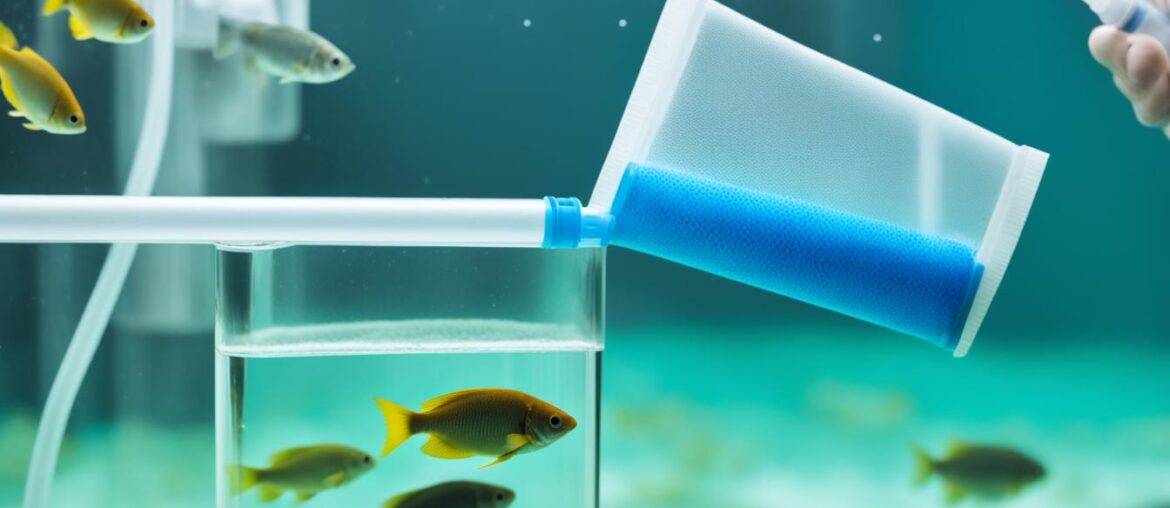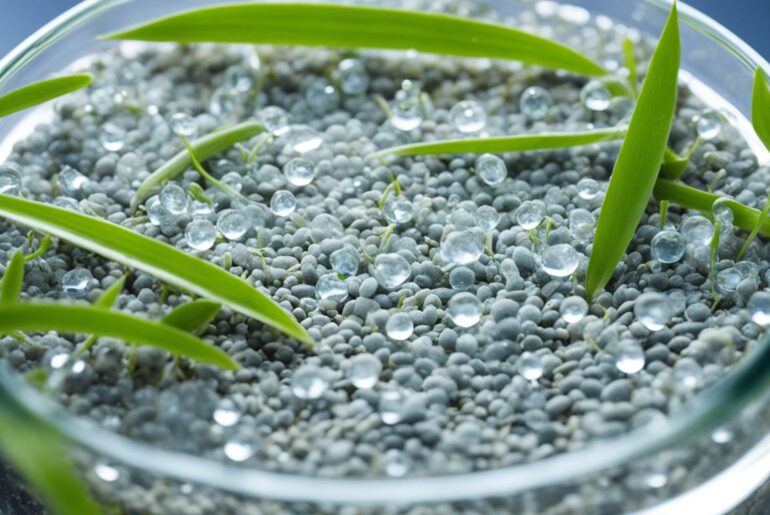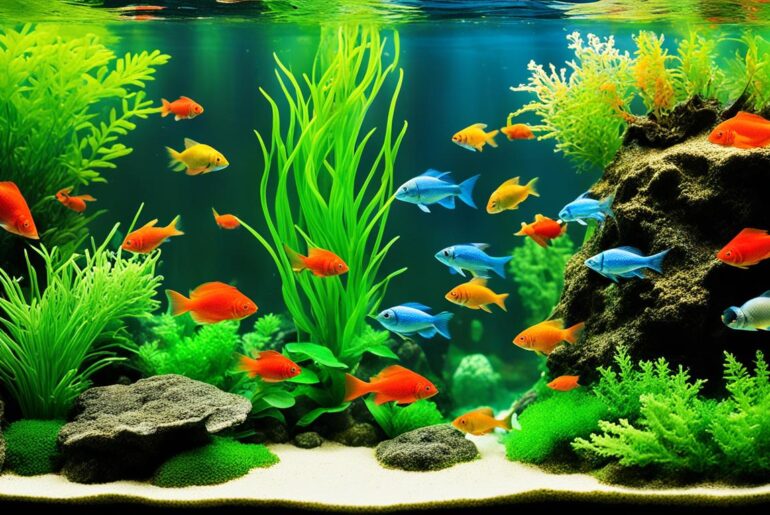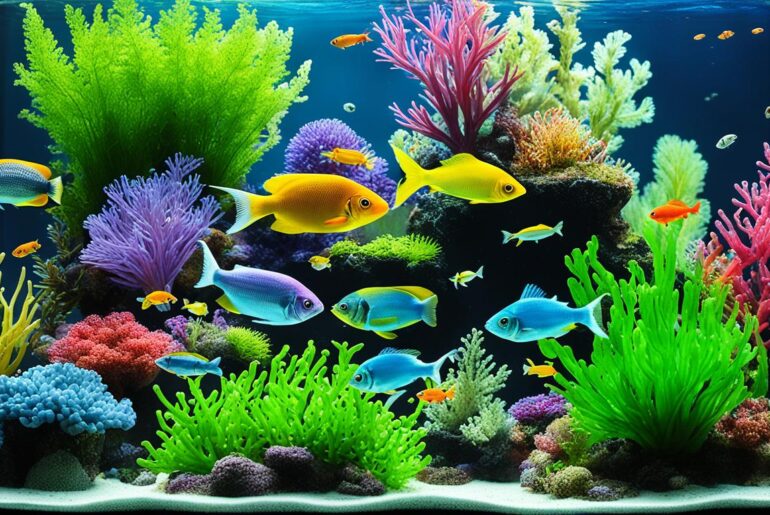Growing up, I always had a deep fascination with aquariums. The vibrant fish, the soothing sound of bubbling water, and the serenity they brought into my home had a profound impact on me. So, when I decided to set up my own aquarium as an adult, I was thrilled. Little did I know that managing ammonia levels during the cycling process would become an unexpected challenge.
As I eagerly filled my tank with water and introduced my fish, I soon realized that there was more to maintaining a healthy aquatic environment than meets the eye. Ammonia, a by-product of fish waste, started to spike, posing a threat to the well-being of my fish. It was a heart-wrenching experience to see them suffer from the toxic effects of high ammonia levels.
Determining the optimal ammonia levels, understanding the nitrogen cycle, and implementing effective strategies to manage ammonia became my top priority. Through extensive research, trial, and error, I learned the invaluable lessons of preventing ammonia spikes and creating a safe haven for my aquatic companions.
In this how-to guide, I will share my insights and practical advice on managing ammonia levels during aquarium cycling. Whether you are a beginner or a seasoned hobbyist, this guide will equip you with the tools and knowledge needed to ensure a healthy and thriving aquatic environment for your fish.
Key Takeaways:
- Understanding the nitrogen cycle is crucial for managing ammonia levels during aquarium cycling.
- High ammonia levels can be toxic to fish and lead to serious health issues.
- Factors like new aquarium setup, overfeeding, and overstocking can contribute to ammonia spikes.
- Methods such as water changes, biological filtration, and bacteria supplements can help lower ammonia levels.
- Regular testing and preventive measures are essential for maintaining optimal ammonia levels in your aquarium.
The Nitrogen Cycle: Understanding the Basics
The nitrogen cycle is a fundamental process that occurs naturally in aquariums, playing a vital role in maintaining a healthy and balanced ecosystem. Understanding the basics of the nitrogen cycle is essential for effectively managing ammonia levels during the cycling process.
During the cycling process, fish waste and uneaten food produce ammonia, a toxic compound that can be harmful to aquatic life. However, beneficial bacteria naturally colonize the aquarium and convert the toxic ammonia into less harmful compounds, such as nitrite and nitrate.
This conversion process is known as the nitrogen cycle and consists of three main stages:
- Ammonia: Fish waste and decaying matter produce ammonia, which is highly toxic to fish.
- Nitrite: Nitrosomonas bacteria convert ammonia into nitrite, which is still harmful to fish but less toxic than ammonia.
- Nitrate: Nitrobacter bacteria further break down nitrite into nitrate, which is the least harmful form of nitrogen compound and can be safely tolerated by most fish.
It’s important to note that nitrate can accumulate over time, and high nitrate levels can still be harmful to certain sensitive fish species. Regular water changes are typically required to maintain optimal water quality and keep nitrate levels in check.
To ensure a successful nitrogen cycle and maintain a healthy aquarium, it’s crucial to establish and maintain colonies of beneficial bacteria. These bacteria can be found in various areas of the aquarium, such as the substrate, filter media, and decorations. Providing ample surface area, such as porous rocks or bio balls, can support the growth of beneficial bacteria.
| Stage | Description |
|---|---|
| Ammonia | Highly toxic compound produced from fish waste and decaying matter. |
| Nitrite | Less toxic compound produced as beneficial bacteria convert ammonia. |
| Nitrate | Least toxic form of nitrogen compound generated by further breakdown of nitrite. |
Understanding the nitrogen cycle and the role of beneficial bacteria is crucial for managing ammonia levels in your aquarium. By providing a suitable environment for bacterial growth and regular monitoring of water parameters, you can ensure a healthy and thriving aquatic ecosystem for your fish. In the next section, we will explore the dangers of high ammonia levels in aquariums.
The Dangers of High Ammonia Levels
High ammonia levels in an aquarium can have severe consequences for the health and well-being of your fish. Ammonia, a toxic compound, can cause significant damage to their organs and overall health if not properly managed.
When ammonia levels become elevated, fish are at risk of experiencing ammonia poisoning. This condition can manifest in various symptoms, including lethargy, difficulty breathing, loss of appetite, and inflammation. If left untreated, ammonia poisoning can be detrimental to fish health and may even lead to fatalities.
To ensure the well-being of your fish, it is crucial to monitor and control ammonia levels in your aquarium. Regular testing and maintenance are essential to prevent high ammonia levels and mitigate the risk of ammonia poisoning.
“High ammonia levels in the aquarium can be deadly for fish. It is crucial to take immediate action to prevent organ damage and protect the overall health of your aquatic pets.”
Managing ammonia levels involves implementing effective filtration systems, practicing proper feeding habits, and conducting routine water changes. By maintaining optimal ammonia levels, you not only safeguard your fish from the damaging effects of ammonia poisoning but also create a healthy and thriving aquatic environment.

Causes of Ammonia Spikes During Aquarium Cycling
During the cycling process of an aquarium, it’s important to understand the causes of ammonia spikes. These spikes can be detrimental to the health of your fish and other aquatic life. Below are some of the key factors that can contribute to ammonia spikes:
New Aquarium Setup
When setting up a new aquarium, it takes time for the beneficial bacteria to establish and convert ammonia into less harmful compounds. During this initial phase, ammonia levels can spike, posing a risk to your fish.
New Livestock Additions
Introducing new fish or other aquatic animals to your aquarium can disrupt the balance of the nitrogen cycle. The arrival of new livestock can result in an increase in waste production, leading to higher ammonia levels.
Presence of Dead Organic Matter
Dead organic matter, such as uneaten food, decaying plants, or dead aquatic life, can release ammonia into the water. If not promptly removed, the decomposition process can contribute to ammonia spikes.
Overfeeding
Feeding your fish more than they can consume within a few minutes can lead to excess food sinking to the bottom of the tank. The decomposition of leftover food releases ammonia, causing ammonia levels to rise.
Overstocking the Aquarium
Having too many fish or overcrowding your aquarium can put a strain on the biological filter’s ability to process ammonia. A high fish population means more waste production, resulting in elevated ammonia levels.
It’s crucial to address these causes of ammonia spikes during the cycling process to ensure a stable and healthy aquatic environment for your fish.
Tips:
- Gradually introduce new fish to the aquarium to minimize the impact on the nitrogen cycle.
- Regularly remove any dead organic matter from the tank.
- Feed your fish small amounts at a time and ensure they can consume all the food within a few minutes.
- Be mindful of the recommended fish stocking levels to maintain a healthy balance in your aquarium.
| Cause | Description |
|---|---|
| New Aquarium Setup | Beneficial bacteria haven’t established yet to convert ammonia. |
| New Livestock Additions | Introduction of more fish or aquatic animals increases waste production. |
| Presence of Dead Organic Matter | Decomposition of uneaten food, decaying plants, or dead aquatic life. |
| Overfeeding | Excess food decomposes and releases ammonia. |
| Overstocking the Aquarium | Biological filter strain due to excessive fish waste production. |
How to Lower Ammonia Levels in Aquariums
Lowering ammonia levels in aquariums during the cycling process is essential for creating a healthy environment for your fish. Here are several effective methods you can use:
- Perform Regular Water Changes: Regularly changing a portion of the water helps dilute and remove excess ammonia. Aim for a 25% water change every week to maintain optimal ammonia levels.
- Increase Biological Filtration: Enhancing the biological filtration in your aquarium promotes the growth of beneficial bacteria that convert ammonia into less harmful compounds. Consider adding filter media with a high surface area for bacterial colonization.
- Add Beneficial Rock: Incorporating live or porous rocks into your aquarium can provide additional surface area for beneficial bacteria to thrive, effectively reducing ammonia levels.
- Upgrade Filtration System: If you have a smaller or inefficient filtration system, consider upgrading to a more powerful and effective one. A larger filter with a higher flow rate can better handle ammonia and maintain water quality.
- Use Bacteria Supplements: Bacteria supplements, such as liquid or powder forms, contain beneficial bacteria that can quickly establish the nitrogen cycle in the aquarium. Follow the manufacturer’s instructions when adding these supplements.
- Utilize Chemical Media: Activated carbon or other specific chemical media can help remove ammonia from the water. Place the media in your filtration system according to the manufacturer’s recommendations to effectively reduce ammonia levels.
By implementing these methods, you can actively manage and lower ammonia levels in your aquarium, providing a healthier environment for your fish to thrive.

Best Practices for Managing Ammonia Levels in Cycling Aquariums
When it comes to managing ammonia levels in cycling aquariums, there are some important best practices to follow. By implementing these practices, you can create a safe and healthy environment for your fish and maintain optimal ammonia levels.
1. Ensure the aquarium is fully cycled before adding fish: Before introducing any fish to your aquarium, it’s crucial to ensure that the cycling process is complete. This means that the beneficial bacteria have established and are effectively converting ammonia into nitrite and nitrate. Testing the water parameters is essential to determine if the aquarium is fully cycled.
2. Test water parameters frequently: Regularly testing the water parameters is vital to monitor ammonia levels and ensure they are within the safe range for your fish. Use a reliable aquarium test kit, focusing on ammonia levels, nitrite levels, and nitrate levels. By consistently monitoring and addressing any fluctuations, you can promptly manage ammonia levels and maintain a healthy aquatic environment.
3. Add fish slowly over time: It can be tempting to add all your desired fish to the aquarium at once. However, it’s important to introduce fish gradually. Adding too many fish at once can lead to an increase in waste production and a spike in ammonia levels. By adding fish slowly, you allow the biological filtration to adjust and effectively manage the waste produced by the fish.
4. Regularly perform water changes: Water changes play a crucial role in managing ammonia levels. They help remove accumulated toxins, dilute excess ammonia, and maintain overall water quality. Aim for regular partial water changes, typically around 20% every 1-2 weeks. However, the frequency and volume of water changes may vary depending on your specific aquarium and its inhabitants.
5. Maintain a balanced and appropriate fish stocking: Overstocking the aquarium can lead to excessive waste production, resulting in high ammonia levels. It’s essential to research and understand the appropriate stocking levels for your aquarium’s size and filtration capacity. Avoid overcrowding and provide ample space for each fish to thrive.
Expert Tip: The key to managing ammonia levels in cycling aquariums is consistency and patience. Keeping up with regular maintenance, monitoring water parameters, and gradually introducing fish will help maintain a stable and healthy environment for your aquatic pets.
Implementing these best practices will greatly contribute to managing ammonia levels effectively in your cycling aquarium. By creating a fully cycled and well-maintained habitat, you provide the optimal conditions for your fish to thrive and minimize the risk of ammonia-related issues.
Fish Stocking Guide
To assist you in determining the appropriate stocking levels for your aquarium, refer to the table below. It provides a general guideline based on the tank size and the type of fish species.
| Tank Size (Gallons) | Small Fish (1 inch) | Medium Fish (3 inches) | Large Fish (6 inches) |
|---|---|---|---|
| 10 | 5 | 2 | 1 |
| 20 | 10 | 4 | 2 |
| 30 | 15 | 6 | 3 |
Note: It’s important to research the specific needs and behaviors of individual fish species to determine the best-suited tank size and compatibility.
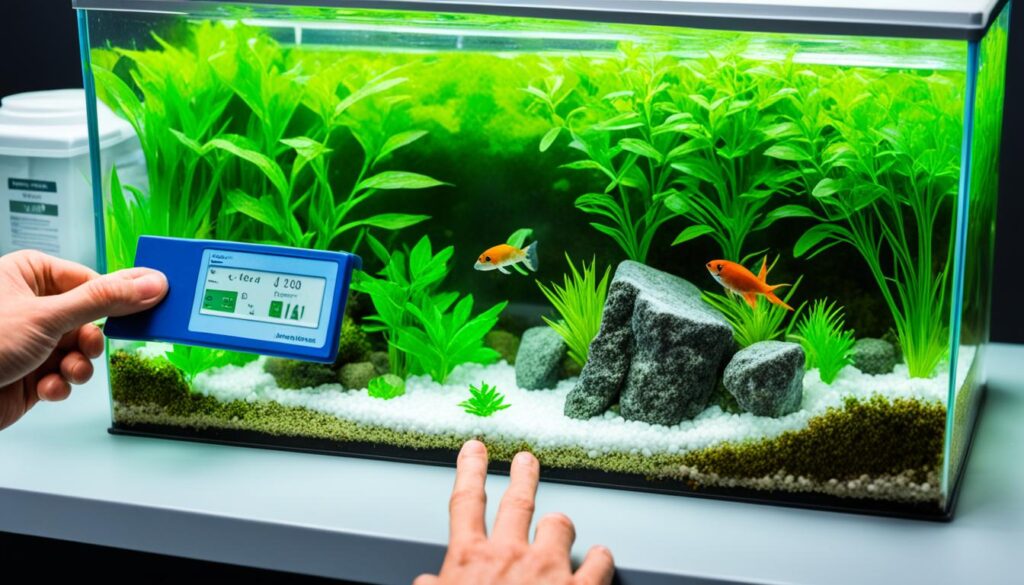
Solutions for High Ammonia Levels During Aquarium Cycling
If you encounter high ammonia levels during the cycling process, there are several effective solutions you can implement to address the issue and ensure the well-being of your fish.
Perform Water Changes
One of the simplest and most immediate solutions to reduce high ammonia levels is to perform regular water changes. This process involves removing a portion of the aquarium water and replacing it with fresh, dechlorinated water. Water changes help dilute the ammonia concentration and lower overall levels in the tank.
Add Cycled Filters
An effective way to promote bacterial growth and enhance ammonia removal is by adding cycled filters to your aquarium. Cycled filters contain beneficial bacteria that help break down ammonia and convert it into less harmful compounds. By introducing established filters from a cycled tank, you can jumpstart the biological filtration process and accelerate ammonia removal.
Use Water Conditioner
To detoxify ammonia in the water, consider using a water conditioner specifically designed to neutralize harmful substances. Water conditioners work by converting toxic ammonia into a less harmful form, making it safer for your fish. When selecting a water conditioner, choose one that explicitly states its effectiveness against ammonia.
Remove Filter Media
Filter media, such as activated carbon or ammonia-absorbing resins, can help remove excess ammonia from the water. However, these materials can also become saturated and lose their effectiveness over time. If you notice persistently high ammonia levels, it might be necessary to remove and replace the filter media to ensure optimal ammonia removal.
Implementing these solutions can significantly lower high ammonia levels in your aquarium and provide a healthier environment for your fish. Remember to monitor ammonia levels regularly and take appropriate action if levels start to rise again.
| Solutions | Description |
|---|---|
| Perform Water Changes | Regularly replace a portion of the aquarium water with fresh, dechlorinated water to dilute ammonia levels. |
| Add Cycled Filters | Introduce established filters from a cycled tank to promote bacterial growth and enhance ammonia removal. |
| Use Water Conditioner | Utilize a water conditioner that neutralizes ammonia and converts it into a less harmful form. |
| Remove Filter Media | Replace saturated filter media, such as activated carbon or ammonia-absorbing resins, to ensure optimal ammonia removal. |
Testing for Ammonia Levels in Aquariums
Regularly testing ammonia levels in your aquarium is essential for effectively monitoring and managing ammonia levels during the cycling process. By testing the water, you can accurately measure the concentration of ammonia present and take appropriate actions to maintain optimal levels for the health of your fish.
One of the most reliable and widely used methods for testing ammonia levels is by using aquarium test kits. These kits are designed to provide accurate and easy-to-read results, enabling you to effectively monitor the ammonia levels in your aquarium.
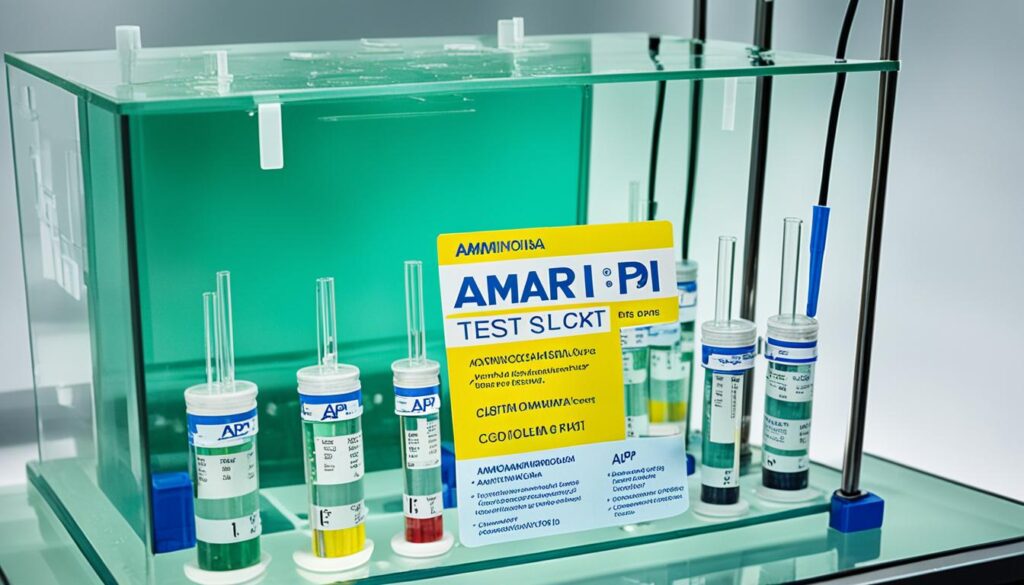
The API ammonia test kit is a popular choice among aquarium enthusiasts. It offers a simple and straightforward testing process, allowing you to quickly and accurately measure the ammonia content in your aquarium water. The kit includes all the necessary components and instructions for performing the test.
Here’s how you can use the API ammonia test kit:
- Start by filling a test tube with a water sample from your aquarium.
- Add the ammonia test solution drop by drop into the test tube, following the instructions provided with the kit.
- Shake the test tube gently to mix the solution and water.
- Observe the color change in the test tube and compare it to the color chart included in the kit.
- Read the corresponding ammonia concentration value from the color chart to determine the ammonia levels in your aquarium.
By regularly testing your aquarium’s ammonia levels using reliable test kits like the API ammonia test kit, you can stay proactive in maintaining a healthy and balanced environment for your fish. Monitoring ammonia levels allows you to take appropriate actions if levels become too high, preventing potential harm to your fish.
Preventing Ammonia Spikes in Aquariums
Preventing ammonia spikes in aquariums is crucial for maintaining a stable and healthy environment for your fish. By implementing the following preventive measures, you can minimize the risk of ammonia spikes and ensure the well-being of your aquatic pets.
Proper Fish Stocking
One of the key factors in preventing ammonia spikes is ensuring proper fish stocking. Overcrowding the aquarium can lead to excessive fish waste, resulting in high ammonia levels. Research the adult size and compatibility of fish species before adding them to your tank, and avoid overstocking to maintain a balanced ecosystem.
Feeding Practices
Another important aspect is maintaining proper feeding practices. Overfeeding can cause excess waste and uneaten food, leading to increased ammonia production. Feed your fish in moderation, ensuring they consume all the food within a few minutes. Consider using slow-release feeders or automatic feeders to regulate the amount and frequency of feeding.
Regular Maintenance
Regular maintenance plays a vital role in preventing ammonia spikes. Perform routine water changes to remove accumulated waste and dilute ammonia levels. It is recommended to change approximately 10-20% of the water every 1-2 weeks, depending on the size of your tank. Additionally, clean the substrate and remove any debris to prevent the buildup of organic matter.
Establishing Nitrifying Bacteria
To maintain a healthy nitrogen cycle and prevent ammonia spikes, it is essential to establish a healthy population of nitrifying bacteria in the aquarium. These beneficial bacteria convert toxic ammonia into less harmful nitrite and then into nitrate. Use products specifically designed to introduce nitrifying bacteria into your tank, such as bacterial supplements or biological filter media.
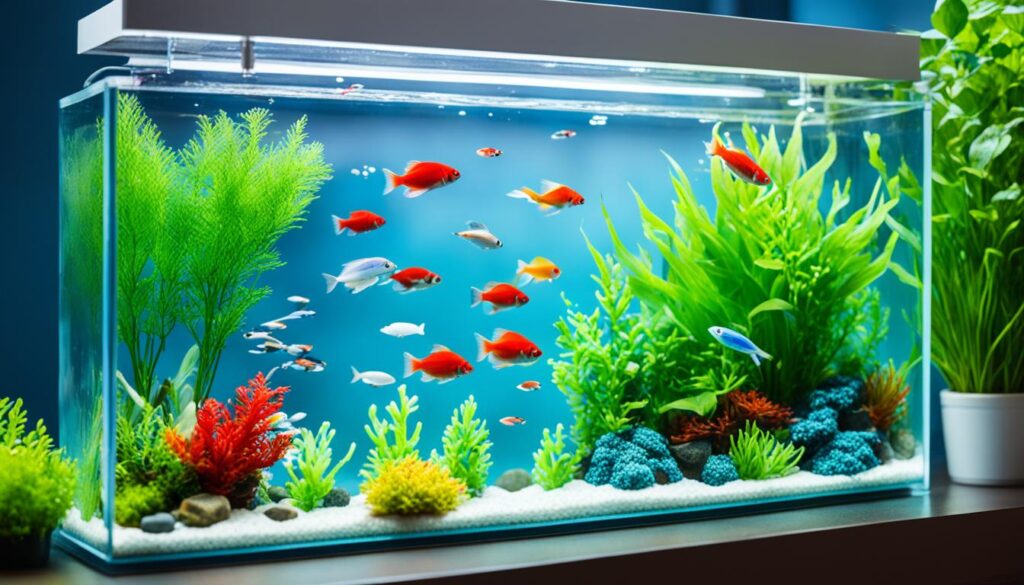
By following these preventive measures, including proper fish stocking, feeding practices, regular maintenance, and establishing nitrifying bacteria, you can create a stable and safe environment for your fish, minimizing the risk of ammonia spikes and promoting their overall well-being.
Conclusion
Managing ammonia levels during aquarium cycling is essential for maintaining a healthy and thriving aquatic environment for your fish. By understanding the nitrogen cycle and implementing appropriate techniques, you can effectively control ammonia levels and ensure the well-being of your fish.
Throughout this guide, we have explored the importance of monitoring ammonia levels, preventing ammonia spikes, and implementing best practices. By creating a fully cycled aquarium, testing water parameters regularly, and adding fish slowly, you can minimize the risk of high ammonia levels and ammonia poisoning.
Remember to perform water changes, increase biological filtration, and consider using beneficial rock or upgrading your filtration system to reduce ammonia levels. Additionally, adding bacteria supplements or using chemical media can further support the nitrogen cycle and maintain optimal ammonia levels.
By following these guidelines, you can create a safe and healthy environment for your fish, ensuring that their ammonia levels are properly managed throughout the aquarium cycling process. Take the necessary precautions, stay vigilant, and enjoy the beauty of your thriving aquarium.
FAQ
What is the nitrogen cycle in an aquarium?
The nitrogen cycle is a natural process that occurs in aquariums and is essential for maintaining a healthy ecosystem. During the cycling process, beneficial bacteria convert toxic ammonia into less harmful compounds, such as nitrite and nitrate.
Why are high ammonia levels dangerous for fish?
High ammonia levels in an aquarium can be extremely dangerous for fish. Ammonia is toxic to fish and can cause damage to their organs and overall health. If ammonia levels are not properly managed, it can lead to ammonia poisoning, resulting in lethargy, difficulty breathing, loss of appetite, and inflammation.
What can cause ammonia spikes during the aquarium cycling process?
Several factors can contribute to ammonia spikes during the cycling process, including setting up a new aquarium, adding new livestock, the presence of dead organic matter, overfeeding, and overstocking the aquarium. Each of these factors can introduce excess ammonia into the tank and lead to ammonia spikes if not managed properly.
How can I lower ammonia levels in my aquarium during the cycling process?
There are several methods to lower ammonia levels in aquariums during the cycling process. These include performing regular water changes, increasing biological filtration, adding beneficial rock, upgrading the filtration system, using bacteria supplements, and using chemical media.
What are the best practices for managing ammonia levels in cycling aquariums?
To effectively manage ammonia levels in cycling aquariums, it is important to follow best practices. These include ensuring the aquarium is fully cycled before adding fish, testing water parameters frequently, and adding fish slowly over time.
What are the solutions for high ammonia levels during the cycling process?
If you encounter high ammonia levels during the cycling process, there are several solutions you can implement to address the issue. These include performing water changes, adding cycled filters to promote bacterial growth, using water conditioners to detoxify ammonia, and removing filter media that can absorb and remove ammonia.
How can I test for ammonia levels in my aquarium?
Regularly testing ammonia levels in aquariums is vital for monitoring and managing ammonia levels during the cycling process. Using aquarium test kits, such as the API ammonia test kit, allows you to accurately measure and track ammonia levels in your aquarium.
How can I prevent ammonia spikes in my aquarium?
Preventing ammonia spikes in aquariums is key to maintaining a stable and healthy environment for fish. This can be achieved by proper fish stocking, avoiding overfeeding, performing regular maintenance, and establishing a healthy population of nitrifying bacteria in the aquarium.
What should I do to manage ammonia levels during aquarium cycling?
Managing ammonia levels during aquarium cycling is crucial for creating a healthy and thriving aquatic environment for fish. By understanding the nitrogen cycle, monitoring ammonia levels, and implementing appropriate techniques and solutions, you can successfully manage ammonia levels and promote the well-being of your fish.
Is it important to manage ammonia levels during the cycling process?
Yes, managing ammonia levels during the cycling process is important to ensure a healthy and thriving aquatic environment for your fish. High ammonia levels can be harmful to fish and can lead to ammonia poisoning and other health issues.
